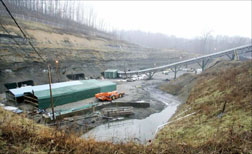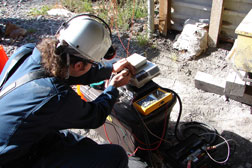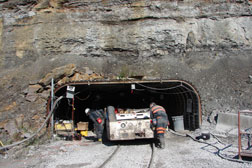NEWS RELEASES
FOR IMMEDIATE RELEASE
December 18, 2006
Sandia researchers study possibility that lightning was cause of Sago Mine disaster
Team visits mine to conduct experiments
 Long distance view of the Sago Mine.
Long distance view of the Sago Mine.Download 300dpi JPEG image, “sago1.jpg,” 412K (Media are welcome to download/publish this image with related news stories.)
ALBUQUERQUE, N.M. — In early November a team of staff members from Sandia National Laboratories visited the Sago Mine near Buckhannon, W.Va. to study the possibility that lightning was the cause of the Jan. 2, 2006 fatal explosion that killed 12 miners.
The researchers took their monitoring equipment across country and spent 10 days analyzing whether an electric current produced by a lightning strike could transmit effects deep into the coal mine.
What they found has the potential to set new standards for lightning protection in the U.S. mining industry.
“We never expected to discover a smoking gun, nor did we,” says Larry Schneider, senior manager of Sandia's Electromagnetic, Stockpile Support and Work for Others Department. “However, we did characterize a coupling mechanism that the team of accident investigators hadn't pursued — that current from a surface lightning strike can generate electromagnetic fields that can readily propagate through the earth, as opposed to current being driven into conductors entering the mine such as metal rails or power lines. The correlation between our field measurements and analytical models is quite impressive.”
 Sandia researcher Matt Higgins prepares to take transfer
measurements as part of several experiments he and a team from
Sandia conducted recently at the Sago Mine.
Sandia researcher Matt Higgins prepares to take transfer
measurements as part of several experiments he and a team from
Sandia conducted recently at the Sago Mine.Download 300dpi JPEG image, “sago2.jpg,” 796K (Media are welcome to download/publish this image with related news stories.)
“Energy can be transmitted deep into the mine without physical conductors being present on or near the surface. This has profound implications, however, our role in supporting the Mine Safety and Health Administration (MSHA) is very clear in scope. We are analyzing the potential electromagnetic effects of lightning at SAGO, not drawing conclusions regarding the cause of the methane explosion that led to this tragedy. That task belongs to MSHA; they have the expertise to interpret our results. ”
The Sandians, including Matt Higgins, Dawna Charley and Leonard Martinez conducted the experiments at the mine with support from Marv Morris, a contracted consultant and former Sandian. Higgins, Charley and Martinez worked at the site from Nov. 1-10.
Sandia is a National Nuclear Security Administration (NNSA) laboratory.
The Mine Safety and Health Administration — aware of Sandia's decade of work studying lightning, particularly how it might impact critical facilities at the Pantex Plant located outside Amarillo and underground facilities at the Nevada Test Site — requested the team to conduct the experiments.
MSHA is charged with writing a report on possible causes of the deadly explosion that should be completed sometime near the one-year anniversary of the event. They intend to include in their report data and analysis from Sandia's investigations.
“Accident investigators have been suspicious all along that lightning was the cause of the explosion, but there has been no definite proof one way or the other,” Michele Caldwell, manager of Sandia's Electromagnetic Qualification and Engineering Department, says.
 This picture shows the entrance of the Sago Mine taken
taken by Sandia researchers who recently visited the mine to
study the possibility that lightning was the cause of the Jan.
2, 2006 explosion that killed 12 miners.(Photo
by Bill Doty)
This picture shows the entrance of the Sago Mine taken
taken by Sandia researchers who recently visited the mine to
study the possibility that lightning was the cause of the Jan.
2, 2006 explosion that killed 12 miners.(Photo
by Bill Doty)Download 300dpi JPEG image, “sago3.jpg,”976K (Media are welcome to download/publish this image with related news stories.)
Multiple lightning strikes, including one of much greater than normal power, were recorded within a five-mile radius of the mine entry point on Jan. 2, 2006 at about 6:26 a.m. At virtually the exact same instant, methane ignited in a recently sealed area of the mine, blowing out the seals and filling it with smoke, debris, fumes and lethal levels of carbon monoxide. Accident investigators are not sure of the cause of the methane ignition and haven't resolved how the lightning energy might have entered the recently sealed area.
Twenty-nine miners were underground at Sago when the explosion occurred. Thirteen were in close proximity to the blast. As was later learned, the force of the explosion killed one miner, and 12 others retreated behind a curtain at the working face of the mine in an attempt to barricade themselves against the smoke and carbon monoxide. They awaited rescue there, which would come too late for all but one of them.
With lightning as a potential cause for the Sago Mine explosion, the Sandia team investigated two modes of transmitting lightning energy deep into the coal mine, Caldwell says.
The first mode was direct attachment onto metallic penetrations — such as conveyers used to extract the coal, rails used for transporting people and equipment — and power and communication lines from the entrance to deep inside the mine. The second was propagating energy through the earth's surface from the point of a surface lightning strike or near-by arc channel.
“We needed to be able to make measurements without waiting for or triggering a true lightning strike in the vicinity, so we needed to provide our own drive signal,” Caldwell says. “To prevent interference with mine operations or introduction of a safety hazard, we injected a small, continuous signal over a range of frequencies present in a lightning strike as a drive source.”
For the metallic penetrations, the drive signal was applied at the entrance to the mine and signals were measured with current and voltage probes at various points in the mine, as far as two miles in. The drive signal was transmitted by fiber optics to the entrance of the mine as the instrumentation was carried into the mine to also make measurements. The goal was to see how much the signals attenuated as a function of the distance of the drive signal. The measurements will be compared to transmission line models of the penetrations developed by Sandia.
For measuring propagation of lightning energy from the surface of the earth to the mine cavern 300 feet below, the drive signal was applied to a long wire stretched on the surface. Directly below inside the mine, an antenna was set up to pick up the transmitted signals. Multiple antenna measurements were made, covering a cross pattern in the mine of about 80 meters by 80 meters. The measurements were compared to analytical models simulating lightning field propagation through the earth.
The data will be used to develop electrical transfer functions, which can be combined with a theoretical lightning strike to determine if voltages get high enough inside the mine to be of concern.
Schneider says this study of the Sago mine accident was a “short term program to characterize the electromagnetic coupling paths of lightning into the sealed area of the Sago underground coal mine and to compare these levels to those that would be required to produce an ignition source deep in the mine.”
“The hope after this initial program is that we will continue to work with MSHA to build a national program to secure mines from the effects of lightning in the future,” Schneider says.
Sandia is a multiprogram laboratory operated by Sandia Corporation, a Lockheed Martin company, for the U.S. Department of Energy’s National Nuclear Security Administration. Sandia has major R&D responsibilities in national security, energy and environmental technologies, and economic competitiveness.
Sandia news media contact: Chris Burroughs, coburro@sandia.gov, (505) 844-0948